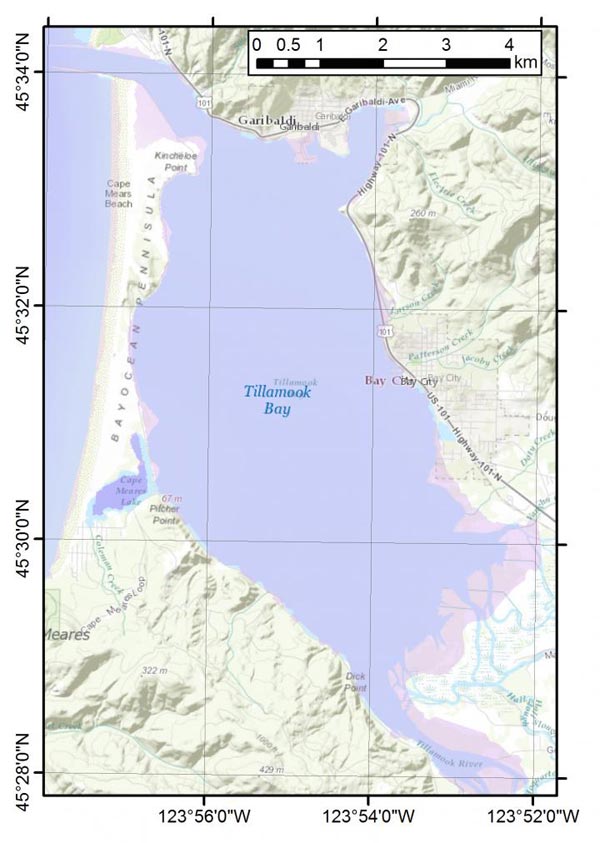
Forecasting Future Flooding in Coastal Pacific Northwest Cities

The pink shaded area shows the land inundated (flooded) during a sample storm.
Credit: Researcher David Hill, Oregon State University
The Pacific Northwest is dotted by small, low-lying, coastal cities where populations tend to cluster. These communities can be isolated and are susceptible to devastation from major storms that bring substantial wind, waves and storm surge.
With climate change, it is anticipated that storms will only become more frequent and intense, signifying a need to understand how the areas will be affected.
David Hill, a researcher at Oregon State University, is focused on the hydrology and hydrodynamics in coastal areas, which represent the boundary between terrestrial and marine environments. His research on future levels of flooding in Tillamook Bay was published in the Journal of Geophysical Research in January 2015.
“This particular project is a blending of our interests in estuarine and coastal hydrodynamics and our interests in climate change,” Hill said. “We're interested in getting a good quantitative understanding of the extreme water levels we can expect from coastal flooding.”
Unlike the South or East coast of the United States, coastal flooding in the Pacific Northwest comes primarily from large waves generated by major storms instead of hurricanes.
“We get big storms here, it's not uncommon to see wave heights that are 10 meters,” Hill said. “Those waves do a couple of things, they can overtop dunes and sea walls. There is also a curious effect where as those waves approach shore and break, they actually push the water up, creating a storm surge effect.”
Storm surge is the abnormal rise of water generated by a storm, causing extreme flooding in coastal areas. It is costly, often leading to the damage or loss of houses and businesses, as well as the potential loss of life. In a report released by the Intergovernmental Panel on Climate Change (IPCC), climate scientists detailed how carbon emissions will impact future climate, and in turn sea level rise. These changes in climate will also lead to an increase in extreme storms and flooding in the future.
Hill and his team of researchers wanted to quantify exactly how flooding will change in the Pacific Northwest on a decadal to century time scale. The researchers developed a novel approach to the issue by using climate data from the IPCC and directly modeling all of the components that cause flooding at the coast including, waves, tides, winds blowing over the surface of the ocean and estuaries, precipitation, and stream flow.
Through an allocation with the National Science Foundation Extreme Science and Engineering Discovery Environment (NSF XSEDE), a national cyberinfrastructure that gives researchers access to advanced digital resources, Hill and his team use advanced computing at the Texas Advanced Computing Center (TACC) to perform their modeling.
“The models we need to simulate year after year of climate data are computationally intensive. They solve key physical equations that govern the transport of water and energy, which requires a fine grid in space and time,” Hill said. “And at the conclusion of our modeling run, we have a multi-year data record of all of these important flooding variables — the raw output is very large.”
Hill has been a TACC user for many years; he began with the Lonestar supercomputer in 2007 and is now using Stampede, one of the most powerful supercomputers in the world.
“My research program changed quite a bit because of those initial projects with Lonestar. Having that kind of access was great because it allowed us to do all these things we couldn't do before,” Hill said. “I ended up pushing a larger percentage of my research portfolio over towards these parallel computing model studies.”
Results from Hill's study allowed the researchers to calculate extreme water levels for different locations in an estuarine environment for 10-year, 50-year, and 100-year periods. Then, the water levels were overlaid on a digital model of a particular area to identify the zones of inundation.
The findings highlight the need to reconsider flood maps that Oregon city planners use for development. Currently, the maps created for future flood zones only show a spatially uniform water elevation. However, Hill's main finding is that these assumptions are invalid. His models show that the level of inundation will vary greatly, even in small bays. According to Hill, another interesting finding was that future extreme water levels were due to more than sea level rise, as waves and tides will be amplified in the future.
Although the flood maps are designed to represent a small area, Hill believes this work could be replicated throughout Oregon and other states in the Pacific Northwest.
“Working with TACC through XSEDE and using supercomputers allowed us to test a hypothesis, and apply physical process based models to coastal areas,” Hill said. “Now, with funding from the Oregon Sea Grant we are working to implement a new strategy and make these kind of results available to other areas in the Pacific Northwest.”












